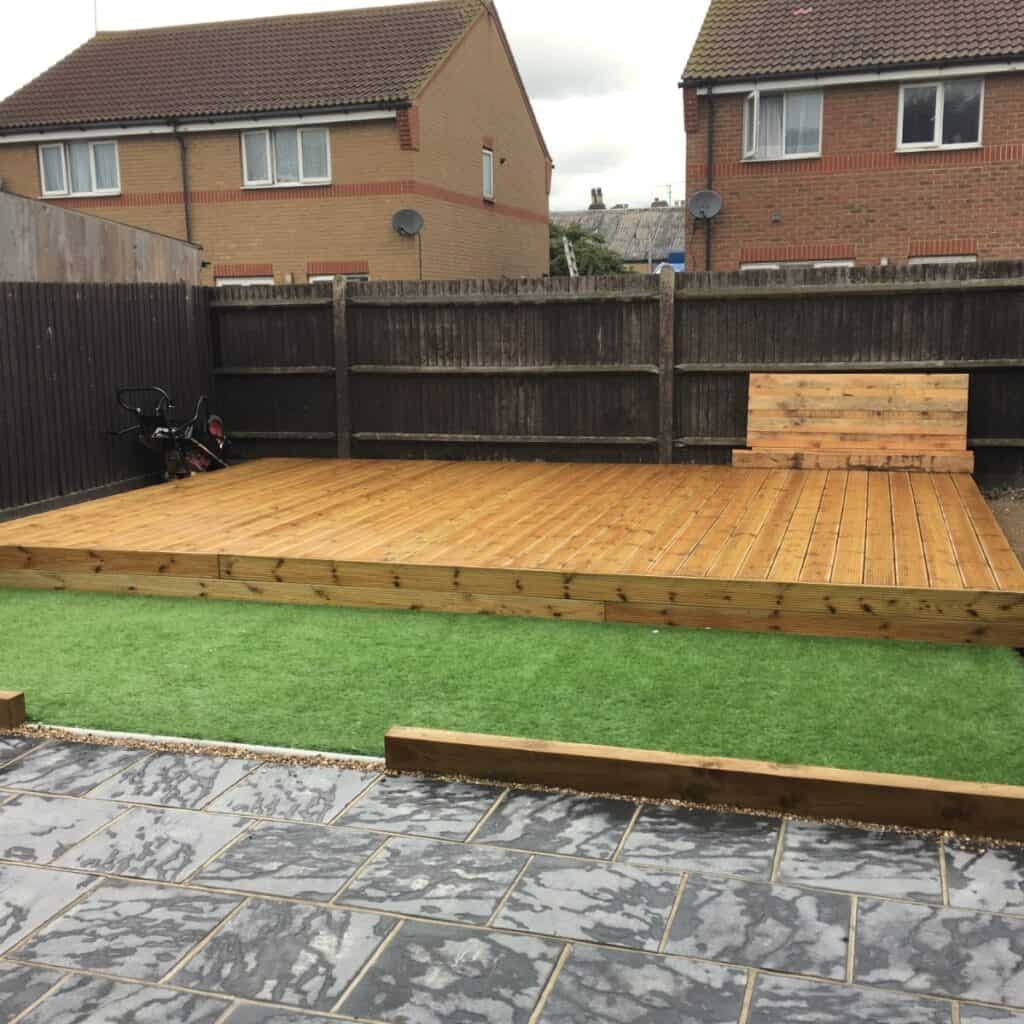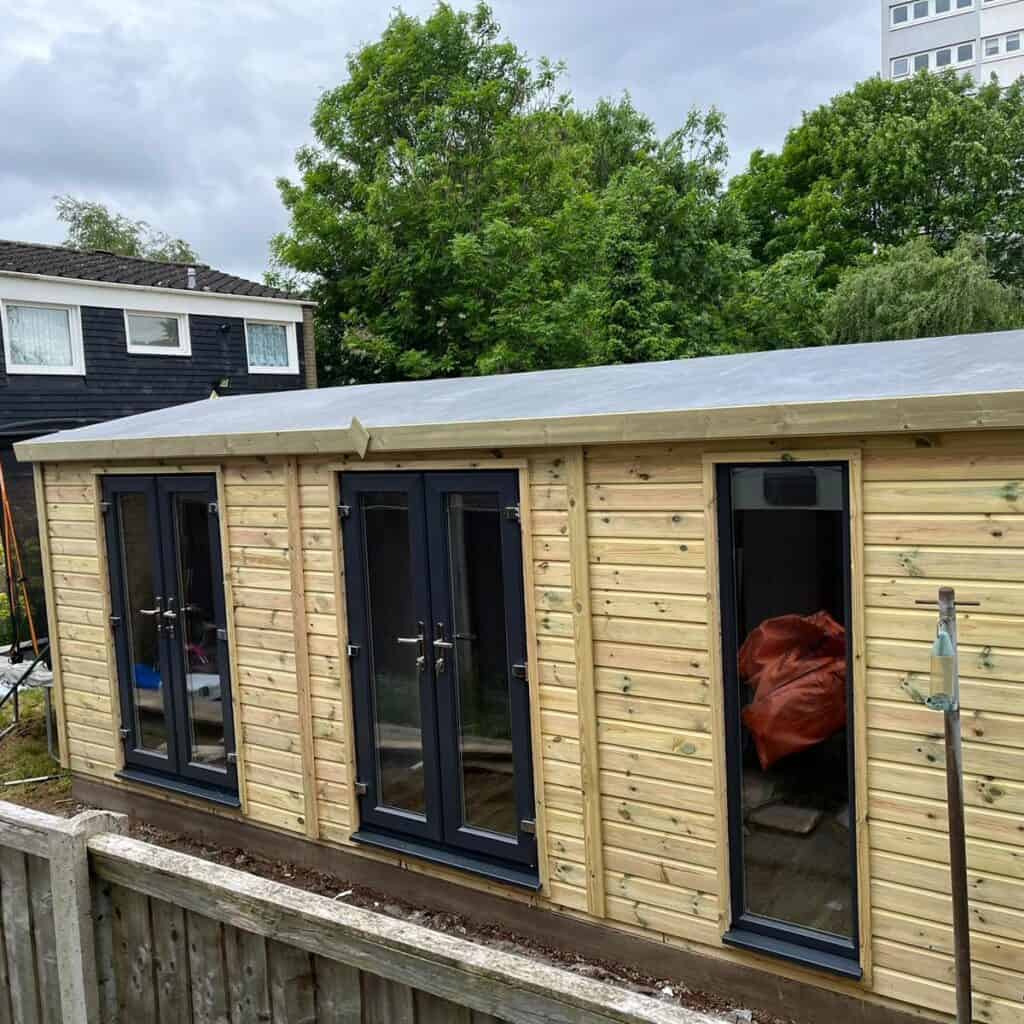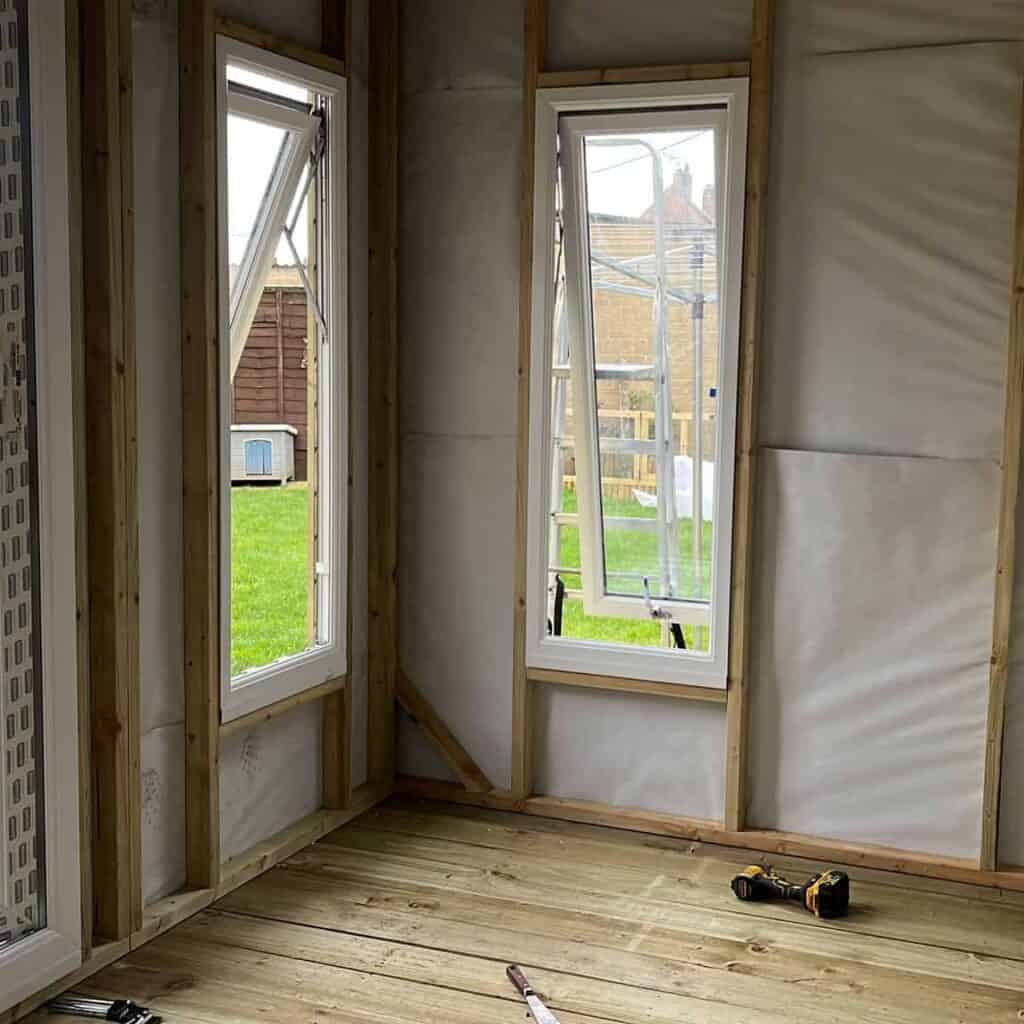When it comes to moving large garden buildings such as sheds and summerhouses, many people are daunted by the task. Whether you’re relocating or simply repositioning your garden structure, there are several important steps to follow to ensure the process is smooth and successful. At Midlands Sheds and Summerhouses, we’ve been approached by numerous removals companies and customers alike, all seeking advice on how to safely dismantle, transport, and reassemble these sizable garden buildings.
Rather than offering individual advice to every query, we’ve put together this comprehensive guide covering every step of the journey. Whether you’re moving large sheds, a garden office, or a summerhouse retreat, this guide will walk you through the process of dismantling, transporting, rebuilding, and maintaining your building for the long term. So, let’s dive in and ensure your project is a success.
Preparing for Dismantling
Before you jump into dismantling your shed or summerhouse, it’s crucial to do some preparation. A lack of proper planning can lead to damage, injury, or costly mistakes. Here are the key steps to take before getting started:
1. Clear Out the Interior
The first step to preparing your garden building for a move is to clear out all its contents. This includes furniture, storage items, and any interior fittings like shelves or cabinets. Emptying the shed or summerhouse will not only make the structure lighter but will also give you a clear view of the interior so that you can identify screws, nails, or bolts that may need to be removed during dismantling.
Make sure you have adequate storage for these items during the move and pack them securely to avoid damage. Label boxes or bags if necessary, especially for screws and small fittings that will be needed later for reassembly.
2. Inspect the Structure
Before dismantling begins, conduct a thorough inspection of the building. Look for signs of wear and tear, such as rotting wood, rusted nails, or sagging roof panels. Any weak spots could complicate the process, making it harder to dismantle without causing further damage. If you identify any serious issues, it might be worth addressing them before proceeding with the move.
Also, ensure that your garden building is structurally sound enough to be taken apart and rebuilt without compromising its integrity. If you have any doubts, it may be worth consulting a professional.
3. Gather the Necessary Tools and Materials
To dismantle your garden building, you’ll need a variety of tools and materials. Depending on the size and type of building, your tool kit might include:
- Screwdrivers (both flathead and Phillips)
- Adjustable spanner or wrench
- Hammer
- Pliers
- Crowbar
- Power drill (for more secure bolts or screws)
- Ladder (for reaching higher parts)
- Protective gloves
- Storage bags or boxes for screws, bolts, and other fittings
Having the right tools on hand will make the dismantling process far smoother and faster. Gather these in advance to avoid frustrating delays in the middle of the job.
4. Plan for Weather and Time
It’s also essential to plan ahead for the best time to dismantle your shed or summerhouse. Weather can significantly impact the success of the process, especially when working with timber buildings. Avoid dismantling during wet, windy, or extremely hot conditions. A dry day with moderate temperatures is ideal, as it ensures you can safely work outside without rushing or risking damage to the wood.
Additionally, dismantling and moving large sheds and other garden building can be time-consuming. Allocate a whole day or even a weekend for the task, depending on the size and complexity of the building. It’s always better to have extra time than to rush the job.

Dismantling a Garden Building: Step-by-Step Guide
With your shed or summerhouse cleared out and fully prepared, it’s time to start the dismantling process. Here’s a detailed breakdown of how to go about it:
1. Remove Roof Felt and Panels
Start from the top by removing the roof felt or panels. In most garden buildings, the roof is secured with nails or screws that can be easily removed with a screwdriver or crowbar. Roof felt may be glued or stapled down, so use a crowbar or similar tool to carefully pry it off. Be gentle when doing this, as you don’t want to damage the roof panels or felt for re-use.
If the roof is made of corrugated metal or polycarbonate sheets, unscrew them carefully and set them aside in a safe place. Ensure you have enough space to store large roof panels temporarily, as these can be bulky. If the roof is covered with EPDM, you may want to wait for the sun to warm the roof to allow it more flexibility. Be aware, the roof is always the most likely part of the structure to break, so ensure you have replacement materials available, or the budget to obtain them.
2. Dismantle Doors and Windows
Next, remove any doors and windows from the structure. Depending on the design of the building, doors and windows may be hinged or screwed in place. Use the appropriate tool to unscrew the hinges or frames and set these parts aside. If the doors and windows are glazed, handle the glass with extra care to avoid breakage during the move.
Make sure all screws, nails, or bolts are stored in labelled bags or containers, as these will be essential for reassembly.
3. Take Down Wall Panels
With the roof and openings removed, you can begin dismantling the wall panels. Most garden buildings are constructed with modular panels, making it easier to break down the structure without excessive force. Start from one corner and work your way around, using a crowbar or drill to loosen the panels.
If the building is constructed from individual boards or logs, dismantle each piece one at a time. Keep an eye out for any connecting bolts, nails, or screws that may be holding the panels together.
When removing each panel, have someone on hand to help lower it safely to the ground. This prevents accidents and ensures the panels are stored without getting damaged.
4. Dismantle the Floor
Finally, the floor can be removed. Depending on the design of the building, the floor may be a single piece or made up of interlocking boards. Use a crowbar to lift the floor panels and remove them one at a time. Be mindful of any beams or joists underneath the floor, as these may also need to be taken apart.
Once dismantled, ensure the panels and beams are stacked neatly for transport.
5. Organise and Store Components
Once everything has been dismantled, organise the parts to make reassembly easier. Group similar components together (e.g., wall panels, roof panels, floorboards), and store screws, bolts, and other small fittings in labelled containers. This will help you avoid confusion when it’s time to rebuild your shed or summerhouse at its new location.
Transporting a Garden Building: Ensuring Safe and Secure Delivery
Now that you’ve successfully dismantled your shed or summerhouse, the next step is transporting it to its new location. This part of the process is often overlooked, but it’s just as important as the dismantling and reassembly stages. Mishandling during transportation can cause damage to your building components, leading to costly repairs or the need for replacements.
In this section, we’ll guide you through the best practices for securely transporting your shed or summerhouse, ensuring all components reach their destination in excellent condition.
Step 1: Plan Your Transportation
The first step in transporting your dismantled garden building is to plan how the components will be moved. The size and weight of the building’s parts, as well as the distance between locations, will influence your approach. Here are the main considerations:
- Transport Vehicle: Depending on the size of your shed or summerhouse, you’ll likely need a van, flatbed truck, or large trailer. Ensure the vehicle has enough space to accommodate all the panels, flooring, roof sections, and other components. UK Man and Van services are available all over the UK, providing not only a van, but one or two strong backs to help you move the panels.
- Helpers: Moving large, heavy panels is not a one-person job. Enlist the help of friends or professionals to assist with loading, securing, and unloading the parts.
- Distance: If you’re moving the shed to a far-off location, consider hiring a professional removals company with experience in handling large, delicate items. Shorter distances may allow for a DIY move, but long hauls often require specialised transport services to ensure safe delivery.
Step 2: Load the Components Securely
Once you have your transport vehicle ready, it’s time to load the dismantled shed or summerhouse. This must be done with care to prevent any damage during transit. Here are some key steps:
1. Start with the Heaviest Components
Begin by loading the heaviest components, such as floor panels, roof beams, and large wall sections. These should be placed on the bottom of the load to create a stable base. Use furniture blankets, foam padding, or similar materials to protect the panels from scratches and dents.
2. Stack Panels Carefully
Stack the wall and roof panels on top of the heavier floor sections. Be mindful of the order in which you’ll need to access them during reassembly – for example, place the roof panels at the top, as these will be the last to be reinstalled. Make sure panels are lying flat, and avoid overloading the vehicle to prevent damage to the panels.
3. Secure the Load
Use ratchet straps, bungee cords, or other securing mechanisms to firmly hold the load in place. This will prevent the panels from shifting during transit, which could cause damage or lead to accidents. Double-check that everything is tightly secured before setting off.
4. Store Small Parts Safely
Smaller components like screws, bolts, and fittings should be placed in labelled containers or bags and stored securely in the vehicle. It’s a good idea to keep these parts in a separate compartment or box to prevent them from getting lost during transport.
Step 3: Drive Carefully and Consider Weather Conditions
With everything loaded and secured, it’s time to transport your shed or summerhouse to its new location. Driving carefully is essential to ensuring the safety of both the building components and the people involved in the move.
- Drive Slowly: Take extra care when driving, especially over bumpy roads, potholes, or uneven surfaces. Sudden stops or sharp turns could shift the load and cause damage.
- Monitor the Weather: If possible, avoid transporting your garden building in rainy or excessively windy weather. Water damage can occur if your timber panels aren’t properly protected, and high winds can make it dangerous to handle large panels during unloading. If you must transport in bad weather, ensure all parts are covered with tarpaulin or waterproof sheets.
Step 4: Unload and Organise
Upon reaching your destination, the unloading process should be handled just as carefully as the loading. Here’s how to manage the task efficiently:
1. Unload in Reverse Order
Begin by unloading the smaller and lighter parts, then move on to the larger panels. If you’ve loaded in the proper order, the floor sections should come out last, as they will be the first to be installed during reassembly.
2. Organise Components by Type
Once unloaded, organise the components in groups – wall panels, floorboards, roof sections, etc. Lay them out in a spacious, dry area where they won’t be exposed to the elements. This will make reassembly much smoother and prevent any confusion over which part goes where.
3. Check for Damage
Before proceeding to the next stage, inspect all components to ensure nothing has been damaged during transport. Look out for cracks, warping, or missing parts. If anything appears damaged, assess whether it can be repaired or needs replacing before reassembly.
Rebuilding Your Shed or Summerhouse: Putting It Back Together
With all the components safely delivered and organised, it’s time to begin the reassembly process. Rebuilding a shed or summerhouse is essentially the reverse of dismantling, but there are a few extra considerations to ensure the structure is rebuilt safely and securely.
Step 1: Prepare the Ground
Before reassembling the shed or summerhouse, you must ensure that the ground where the structure will be placed is properly prepared. This is crucial for ensuring that the building is stable and won’t suffer from issues like dampness or subsidence in the future.
1. Level the Ground
If the ground isn’t already level, you’ll need to level it before proceeding. Uneven ground can cause structural problems, such as sagging floors or gaps between panels. Use a spirit level and, if necessary, add sand or gravel to create a flat, even base.
2. Add a Foundation
If your garden building doesn’t already have a dedicated foundation, now is the time to install one. A concrete slab, paving stones, or timber frame foundation will provide a solid base for the shed or summerhouse, protecting it from ground moisture and ensuring longevity.

Step 2: Reassemble the Floor
With the foundation in place, the first part to rebuild is the floor. Follow these steps:
1. Reattach Floor Beams or Joists
If your shed or summerhouse includes beams or joists, these should be installed first. Ensure they’re properly aligned and securely attached to the foundation.
2. Lay the Floor Panels
Once the beams or joists are in place, lay the floor panels on top. Ensure each panel fits snugly and is properly aligned before securing them with screws or bolts.
Step 3: Reinstall Wall Panels
With the floor in place, it’s time to reassemble the walls:
1. Start with Corner Panels
Begin by installing the corner wall panels, as these will provide the main structure for the rest of the walls. Use screws or bolts to secure them to the floor, and ensure they’re perfectly aligned and level before proceeding.
2. Add Remaining Panels
Next, reattach the remaining wall panels. Check that each panel is securely fastened to both the floor and the adjoining panels. It’s essential to maintain the building’s structural integrity, so don’t rush this step.
Step 4: Install Roof Beams and Panels
Once the walls are up, you can move on to the roof:
1. Reattach Roof Beams
If your building includes roof beams, these should be installed first. Ensure they’re securely fastened to the walls and evenly spaced.
2. Reinstall Roof Panels
Finally, reattach the roof panels. If you removed the roof felt or any other coverings, reapply these at this stage. Ensure the roof is watertight by checking for gaps or loose fittings.

Step 5: Reinstall Doors and Windows
The last part of the reassembly process is to reinstall the doors and windows. Ensure that all hinges, latches, and locks are securely fitted and that the doors and windows open and close smoothly. Double-check for any alignment issues that could cause sticking or gaps.
Maintaining Your Newly Rebuilt Shed or Summerhouse
Now that your shed or summerhouse is fully reassembled, it’s essential to keep it in excellent condition so it can serve its purpose for years to come. Regular maintenance can help protect your investment and ensure your building remains sturdy and weather-resistant. Here’s a guide to maintaining your garden building after it has been rebuilt:
1. Apply a Fresh Coat of Paint or Wood Treatment
After dismantling and reassembling, your shed or summerhouse may have been exposed to the elements, or its exterior finish might have been damaged during the move. Applying a fresh coat of paint, stain, or wood treatment is crucial for preserving the timber and protecting it from rot, pests, and weather damage.
Use a high-quality exterior wood treatment or paint designed to resist water, UV rays, and mildew. Ensure that all areas, especially joints and edges, are thoroughly coated to prevent moisture ingress.
2. Check for Gaps or Misalignments
Even with the best care during reassembly, slight misalignments can occur, leaving gaps between panels or around windows and doors. These gaps can allow draughts, rainwater, or even pests to enter. Check the entire structure carefully, and if you spot any gaps, fill them with weatherproof sealant or insulation strips.
Pay close attention to the roof to ensure there are no leaks. If you notice any weak spots, consider adding extra roofing felt or waterproofing materials to safeguard against rain.
3. Ensure Proper Ventilation
Good ventilation is essential for preventing condensation inside your garden building. Condensation can lead to mould growth and wood decay, reducing the lifespan of your shed or summerhouse. To improve airflow, consider installing vents or leaving a slight gap in the windows to allow air circulation without letting in too much moisture.
4. Inspect Regularly for Signs of Wear and Tear
Timber garden buildings naturally expand and contract with changes in temperature and humidity, which can lead to wear and tear over time. Perform a regular inspection every few months to check for signs of wood warping, rot, rusted hardware, or other damage.
Addressing these issues early can prevent more significant problems from developing. For instance, replace rusted hinges or door latches promptly to avoid them breaking, and replace any damaged or rotting boards to maintain the structural integrity of the building.
5. Clean the Exterior and Roof
Dirt, moss, and algae can build up on the exterior of your shed or summerhouse, especially on the roof. Over time, this can lead to wood decay or roof damage. Cleaning your garden building’s exterior at least once a year with a gentle scrub and garden hose will help maintain its appearance and longevity.
Avoid using pressure washers, as they can damage the wood or roofing felt. Instead, opt for a soft-bristled brush and mild detergent to remove grime without harming the structure.
6. Check and Maintain the Base
The base of your shed or summerhouse is critical to its stability and longevity. Make sure the foundation remains level and free from water pooling. If your building is on a timber base, check that the wood hasn’t rotted or shifted. For concrete or paving stone bases, clear any debris and check for cracks.
Maintaining the base is essential for keeping your building sturdy and reducing the risk of structural problems.
Should You Move Your Garden Building or Leave It?
While moving large sheds or summerhouses can be a practical solution in many cases, it’s important to weigh up whether it’s truly worth the effort. Here are a few points to consider:
1. Impact on the Building’s Lifespan
Dismantling and reassembling a garden building can weaken its structure, particularly if it’s an older model or has already experienced some wear and tear. The process of taking the building apart, moving it, and then reassembling it can reduce its overall lifespan, as screws, joints, and panels may not fit as snugly as they once did. It can also leave the building more vulnerable to leaks or rot in the long term.
2. Costs of Moving vs. Buying New
Moving a large garden building can be both time-consuming and costly, especially if professional help is required for transportation and reassembly. In some cases, it may be more cost-effective to sell your existing shed or summerhouse as part of the house sale and invest in a new one at your new location.
A new garden building will offer several benefits: it will come with a fresh warranty, you can select the size and style that best suits your new space, and it will not have been weakened by the moving process. Many buyers are willing to pay more for a property that comes with additional outdoor structures, so leaving it behind could potentially increase the value of your home.
3. Practicality of Moving large sheds and summerhouses
In some cases, the size and condition of your current garden building may make it impractical to move. Older or heavily customised sheds may not survive the process of dismantling and reassembling without significant damage, in which case, starting fresh with a new structure is a more practical choice.
Conclusion
Moving a large shed or summerhouse is a challenging task, but with the right preparation, tools, and care, it can be done successfully. This guide has covered the essential steps from dismantling and transportation to reassembly and maintenance, ensuring your garden building stays in top condition after the move.
However, it’s essential to carefully consider whether moving your garden building is the best option. In some cases, the lifespan of the structure may be compromised by the process, making it more sensible to leave it behind as part of your house sale and invest in a new one. By weighing up the pros and cons, you can make an informed decision that best suits your needs.
Whether you choose to move your shed or summerhouse or leave it behind, proper maintenance and care will keep your garden building in excellent condition for years to come.




